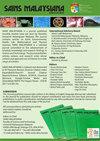Detection of Leptospira wolffii in Water and Soil on Livestock Farms in Kelantan After a Massive Flood
IF 0.8
4区 综合性期刊
Q3 MULTIDISCIPLINARY SCIENCES
引用次数: 0
Abstract
Pathogenic leptospires cause leptospirosis in both animals and humans around the world. Humans can be infected by leptospires through direct contact with infected animals or indirect contact with leptospires contaminated water or soil. Outbreaks of leptospirosis usually occur after heavy rainfall and flooding, particularly in endemic areas. The aim of this study was to detect the presence of leptospires in water and soil in livestock farms after a massive flood in Kelantan. Samples were collected from 28 livestock farms in Kelantan, comprising 62 water samples and 62 soil samples, respectively. The samples were filtered and inoculated into a semisolid EMJH medium containing 5-FU for the isolation of Leptospira spp. The Leptospira spp. isolates were then identified using classical methods (1M NaCl, 8-azaguanine, and 13 °C), serology (MAT), multiplex polymerase chain reaction (mPCR), and DNA sequencing. The classical identification methods showed varying results and failed to differentiate between pathogenic and non-pathogenic leptospires. MAT showed the isolates reactions against serovars Autumnalis, Hebdomadis, Pyrogenes, Bataviae, Patoc, and Wolffii. However, mPCR showed that all isolates were non-pathogenic Leptospira spp. Further identification using DNA sequencing found that all isolates were identified as Leptospira wolffii, an intermediate species of Leptospira. The presence of L. wolffii in water and soil provides evidence that this species is circulating in the environment and could potentially transmit to humans and animals.吉林省吉兰丹市大规模洪涝灾害后农田土壤和水体中wolffii钩端螺旋体的检测
致病性钩端螺旋体在世界各地的动物和人类中都会引起钩端螺旋病。人类可以通过直接接触受感染的动物或间接接触受钩端螺旋体污染的水或土壤而感染钩端螺旋病毒。钩端螺旋体病的爆发通常发生在强降雨和洪水之后,特别是在流行地区。这项研究的目的是检测吉兰丹大洪水后畜牧场的水和土壤中是否存在钩端螺旋体。样本采集自吉兰丹的28个畜牧场,分别包括62个水样和62个土壤样品。将样品过滤并接种到含有5-FU的半固体EMJH培养基中,用于分离钩端螺旋体。然后使用经典方法(1M NaCl、8-氮杂鸟嘌呤和13°C)、血清学(MAT)、多重聚合酶链式反应(mPCR)和DNA测序鉴定钩端旋体。经典的鉴定方法显示出不同的结果,并且未能区分致病性和非致病性钩端螺旋体。MAT显示分离株对Autumnalis、Hebdomadis、Pyrogenes、Bataviae、Patoc和Wolffii血清型有反应。然而,mPCR显示所有分离株均为非致病性钩端螺旋体。使用DNA测序的进一步鉴定发现,所有分离株都被鉴定为钩端螺旋菌的中间种wolffii钩端螺旋虫。wolffii在水和土壤中的存在提供了证据,证明该物种正在环境中循环,并可能传播给人类和动物。
本文章由计算机程序翻译,如有差异,请以英文原文为准。
求助全文
约1分钟内获得全文
求助全文
来源期刊

Sains Malaysiana
MULTIDISCIPLINARY SCIENCES-
CiteScore
1.60
自引率
12.50%
发文量
196
审稿时长
3-6 weeks
期刊介绍:
Sains Malaysiana is a refereed journal committed to the advancement of scholarly knowledge and research findings of the several branches of science and technology. It contains articles on Earth Sciences, Health Sciences, Life Sciences, Mathematical Sciences and Physical Sciences. The journal publishes articles, reviews, and research notes whose content and approach are of interest to a wide range of scholars. Sains Malaysiana is published by the UKM Press an its autonomous Editorial Board are drawn from the Faculty of Science and Technology, Universiti Kebangsaan Malaysia. In addition, distinguished scholars from local and foreign universities are appointed to serve as advisory board members and referees.
 求助内容:
求助内容: 应助结果提醒方式:
应助结果提醒方式:


